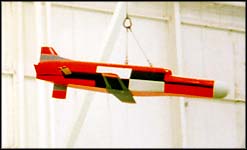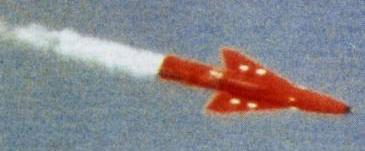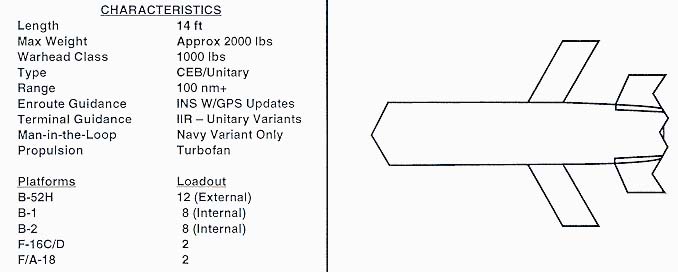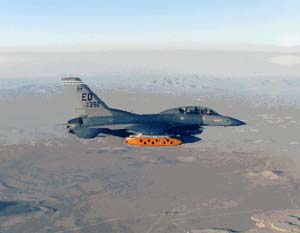 |
|
AGM-65B Maverick
|
Seeker: TV with magnification Speed: Mach 0.65 Length: 8 ft 2 in Weight: 464 lb Warhead: 125 lb shaped charge Range: 0.6 to 14 miles Diameter: Drag factor: 46 |
|
| The Maverick is a "fire and forget" air-to-ground missile, enabling the pilot to seek other targets or leave the area once the missile is launched. The AGM-65B model uses a TV-imaging seeker with scene magnification to allow the pilot to acquire targets from a greater distance. The Maverick employs a high-explosive shaped-charge warhead effective against tanks, trains and other vehicles. | |
AGM-65D Maverick
AGM-45A Shrike
|
Seeker: Passive radar Speed: Length: 10 ft Weight: 395 lb Warhead: 145 lb fragmentation Range: 12 miles Diameter: Drag factor: 40 |
|
| The AGM-45A Shrike is an anti-radiation missile effective against continuous wave /CW/ radar emitters. These include all enemy air defense radar systems except the SA-8 Grecko. While the F-16 lacks the avionic systems to be a true Wild Weasel platform, you may be asked to perform this mission anyway. | |
|
Primary Function: Air-to-surface
anti-ship missile Contractor: McDonnell Douglas Power Plant: Teledyne Turbojet Thrust: 660 pounds Length: 12 feet, 7 inches Weight: 1,145 pounds Diameter: 13.5 inches Wing Span: 3 feet Range: Over the horizon Speed: High subsonic Guidance System: Sea-skimming cruise using radar altimeter; active radar terminal homing Warheads: Penetrating high-explosive (488 lb) Date Deployed: 1985 Air Force Inventory: Classified |
 |
|
The AGM-84D Harpoon is an all-weather, over-the-horizon, anti-ship missile system produced by McDonnell Douglas. Its low-level, sea-skimming cruise trajectory, active radar guidance, and warhead design assure high survivability and effectiveness. Originally developed for the Navy to serve as its basic anti-ship missile for fleetwide use, the AGM-84D Harpoon also has been adapted for use on Air Combat Command's B-52G bombers. The 42nd Bombardment Wing, Loring Air Force Base, Maine, was first tasked to perform the Harpoon mission in 1985. The wing refined tactics and doctrine to merge the long-range, heavy-payload capability of the B-52 with the proven reliability of this superior stand-off attack weapon. These combine to provide the war-fighting capability to interdict ships at ranges well beyond those of other aircraft. |
|
AGM-88A HARM
|
Seeker: Passive radar Speed: Length: 13 ft 9 in Weight: 807 lb Warhead: 145 lb fragmentation Range: 30 miles Diameter: Drag factor: 46 |
|
| The AGM-88A HARM /High Speed Anti-Radiation Missile/ is an upgrade of the Shrike. Towards the end of the Vietnam War, enemy radar operators learned to turn off the radar when they detected a Shrike missile launch. The HARM was developed with a much higher speed and range so it could hit a radar source without warning. It also has a better target acquisition system that is effective against both CW and pulse-dopppler radar. Both the enemy SA-8 Gecko and the allied Roland SAM systems use pulse-doppler radar. | |
|
Contractor: Kongsberg Vaapenfabrikk
(Norway) Power Plant: Solid propellant rocket motor and solid propellant booster Length: 120.48 inches (3.06 meters) Launch Weight: 847 pounds (385 kg) Diameter: 11.2 inches (28.45 cm) Wing Span: 30 in's folded, 55 in's Deployed Range: 25 nautical miles / 35 km Speed: 1.2 Mach Guidance: Inertial and infrared terminal. Warhead: 265 lbs gross, 110 lbs High Explosive, semi armor piercing Date Deployed: 1993 |
 |
|
The Penguin is a helicopter launched anti-ship missile developed for use on Lamps III helicopters and NATO allies. Penguin is the only operational Navy helicopter-launched missile in the Navy's weapon inventory. It provides Navy surface combatants with a defense against surface threats armed with antiship missiles. Navy testing of Penguin has been completed, and it achieved IOC in the fourth quarter of FY 1993. All Block I modified SH-60Bs will be capable of employing Penguin, and eventually all SH-60Bs. The Navy will acquire approximately 100 Mod 3 versions. A principal operational advantage of Penguin is its relatively long operational range, which permits a helicopter armed with Penguin to remain outside the launch envelopes of potential targets. The Penguin missile has an indirect flight path to target. It is also operated in "fire-and-forget" mode to allow multiple target aqusition. The Penguin is fired from a launcher or a stage weighin approximately 1100 pounds (500 kilograms). The Penguin was developed by and for the Norwegian Navy. The Penguin anti-ship missile was conceived in the early 1960's as a ship-borne, anti-invasion defence system. Penguin was the first fire-and-forget anti-ship missile system to be developed in the Western world. Penguin MKI became operational with the Norwegian and Turkish navies in 1972. The MK2 entered service in 1980 with the Norwegian, Hellenic and Swedish navies. Since then, continuous development programs have adapted the concept to the technical evolution of surface warfare. The air-launched penguin MK3 version (AGM-119A) is chosen as the standard anti-ship missile for the F-16 Fighting Falcons of the Royal Norwegian Air Force. and has completed a highly successful Foreign Weapon Evaluation Program conducted by the US Air Force. The Penguin MK2 MOD7 (AGM-119B) with folding wings is adapted to the US Navy LAMPS Mk III, SH-60B helicopters. The Penguin missiles are designed and manufactured by Norsk Forsvarsteknologi (NFT). Penguin is a fully digitized missile with canard control. The high resolution, passive infrared seeker provides a high degree of discrimination and target selection, and ensures efficient operation in confined, as well as open waters. The high accuracy, inertial navigation system ensures the missile's capability of target detection, and provides the flexibility of mid-course trajectory via pilot-designated way-point. An efficient 120 kg warhead, with an impact point close to the target's waterline, will inflict serious damage to medium size surface combatants or other targets. The missile is powered by a solid propellant two stage rocket motor. The Penguin can be adapted to helicopters, fixed wing patrol aircraft as well as fighter aircraft. The missile system is software integrated into the aircraft avionic system. with the use of existing equipment for suspension, control and operation. The National Defense Authorization Act for Fiscal Year 1997 contained a provision that authorized the Navy to enter into a contract for multiyear procurement of not more than 106 Penguin missiles and limited the amount that could be expended for such procurement to $84.8 million. This provision was based on the existing shortfall in Penguin missile inventory and the premise that the Navy would be able to negotiate a very favorable price at around 55 percent of the average unit procurement cost for previous lots. Congress subsequently appropriated $7.0 million to procure Penguin missiles in fiscal year 1997 and $7.5 million in fiscal year 1998. |
|
|
Span 5 ft. 2 in. Length 8 ft. 4 in. Body diameter 2 ft. 3 in. Weight 430 lbs. Armament WDU-30/B 40 lb. blast fragmentation warhead Engine Williams International F121 turbofan of 70 lbs. thrust Cost $200,000 (estimated production version) Cruising speed Subsonic Range air-launched = "More than 50 miles" ground-launched = 430 kilometers |
 |
|
Tacit Rainbow was a project to develop a jet-powered "mini" drone for finding and destroying enemy ground based radars. Designated AGM-136A by the Air Force, the Tacit Rainbow could be carried to target striking distance and air-launched by bombers or fighters, or launched from ground systems. Each vehicle was preprogrammed for a designated target area using the on-board computer and flight control system. Once launched, AGM-136A flew a preprogrammed course to its target area and "loitered" until it detected transmissions from an enemy radar. Once a radar source is detected and identified, the UAV homed in to destroy it. Unlike other anti-radiation missiles, Tacit Rainbow could not be "fooled" if the radar was turned off to avoid being hit. As long as fuel remained, it could wait and reattack that or another radar when operation resumed. The Tacit Rainbow unmanned aerial
vehicle (UAV) was conceived in the early 1980s using experience
gained with anti-radar missiles in Vietnam. Its purpose was to
supplement manned aircraft in striking enemy air defenses. The
vehicle was designed for low cost production so that it could
be used in "swarms" against dense enemy air defense
networks. The first Tacit Rainbow air-launch occurred on July 30, 1984. More than 30 test launches were made, from both bombers and fighters. The MLRS launcher was also used for the Ground Launched Tacit Rainbow. On 21 March 1989 the Acting Secretary
of the Air Force notified the Congress that the current program
acquisition unit cost of the Tacit Rainbow program had increased
by more than 15 percent, and on 23 May 1989 notification was
provided that the Tacit Rainbow Program has exceeded its baseline
unit cost by more than 15 percent. The ground-launched version of the nonnuclear TACIT RAINBOW ALCM had a design range of only 430 kilometers, and was therefore well below the newly agreed START threshold of 600 kilometer range for counting ALCMs. Tacit Rainbow was a purely conventional system and there were no plans to equip it with nuclear warheads; therefore, the 1990 Strategic Arms Reduction Treaty [START] agreement did not have any effect on the US ability to employ it. The Soviet effort to capture Tacit Rainbow was part of their overall effort in START to try to constrain US conventional programs. The ALCM range issue in the START negotiations was a question of what range would mark the threshold between short-range systems not limited by START in any way and long-range nuclear ALCMs which would be covered by START. The US concern on ALCM range was above all to protect US conventional options. Since future non-nuclear ALCMs like Tacit Rainbow will not be limited by START if they are externally distinguishable from nuclear ALCMs, the US accepted the 600 kilometer range threshold in START. As a result of its tough negotiating on this provision, the United States gained concessions which eased the way for the deployment of new conventionally armed cruise missiles such as the highly accurate Tacit Rainbow. Secretary of State Baker agreed to constrain US military programs in a so-called `side letter' to the proposed START framework statement in which the United States agreed not to modernize the Tacit Rainbow ALCM, and also not to equip this ALCM with a nuclear warhead. This letter informed the Soviets of the fact that the US had no plans to convert the non-nuclear Tacit Rainbow ALCM to a nuclear ALCM. In October 1990 Air Force investigators looking into mismangement at Northrop concluded that many of the expensive weapons systems built by that contractor -- including the B-2, the Tacit Rainbow anti-radar missile, the F-15's jamming system, the guidance system for the MX missile -- were riddled with fraud and performance defects. The program was cancelled for budget reasons in 1991, prior to the planned start of production in 1992. During the previous two decades, only two programs were cancelled after full scale testing had commenced and before a substantial amount of serial production: the Army's DIVAD gun (the Sergeant york), and the Tacit Rainbow missile. |
|
|
In 1986, the Air Force began developing TSSAM to provide a low observable conventional cruise missile. Key characteristics included long-range, autonomous guidance, automatic target recognition, and precision accuracy with a warhead able to destroy a well-protected structure. The Tri-Service Standoff Attack
Missile (TSSAM) was a joint service program with the Air Force
as the lead service. The program objective was to develop a family
of highly survivable, conventional, stealthy cruise missiles
to satisfy tri-service requirements to effectively engage a variety
of high value land and sea targets. The technical approach to
develop a modular stealth cruise missile which can employ several
payloads and guidance systems to engage the required targets.
All variants used a GPS aided inertial navigation system. The
Navy and Air Force (unitary variant) missiles used an imaging
infrared terminal sensor for autonomous recognition and homing
on fixed land targets and sea targets. The other Air Force variant
contained the Combined Effects Bomblet (CEB) submunition to attack
land targets. Integration efforts were planned for the Air Force’s
B-52H, F-16C/D, B-1 and B-2 and the Navy’s F/A-18C/D. Northrop Aircraft Division's cost/schedule control system did not provide the Government with reliable data and the data was not promptly submitted; therefore, the Joint System Program Office could not effectively measure the contractor's performance or use the cost data to make informed management decisions. Management of TSSAM Program funds was fragmented among the three Military Departments, resulting in an awkward budgeting process, funding shortfalls, and delays in program and contracting decisions. The system had significant development problems, and estimates of the unit cost in production were unacceptably high. That made it a logical candidate for cancellation. After the TSSAM procurement unit cost increased from an estimated $728,000 in 1986 to $2,062,000 in 1994 (then-year dollars), the Department of Defense (DOD) terminated the program. On 09 December 1994 the Secretary of Defense announced cancellation of the TSSAM program. DEPSECDEF Program Decision Memorandum (PDM) IV, 16 Dec 94, canceled the TSSAM and associated contracts. Many TSSAM program specifics remain SECRET -Special Access Required per the 31 March 1993 Program Security Guide. Following a comprehensive reassessment of force requirements, the Air Force and Navy agreed they urgently needed an affordable missile with most of TSSAM's characteristics. They proposed a joint program that would build upon the lessons learned from TSSAM and more recent programs that use new acquisition approaches. On September 20, 1995, the Principal Deputy Under Secretary of Defense for Acquisition and Technology approved the initiation of the JASSM program, under Air Force leadership. The publicly released retouched photo of TSSAM revealed the vehicle's stealthy shape, but little of engine ports or sensors.
|
|
JASSM is a precision cruise missile
designed for launch from outside area defenses to kill hard,
medium-hardened, soft, and area type targets. The threshold integration
aircraft are the F-16, B-52, and F/A-18 E/F, and the airframe
design is compatible with all JASSM launch platforms: the B-52H,
F-16C/D, F/A-18E/F, F-15E, F-117, B-1B, B-2, P-3C and S-3B. The
weapon is required to attack both fixed and relocatable targets
at ranges beyond enemy air defenses. After launch, it will be
able to fly autonomously over a low-level, circuitous route to
the area of a target, where an autonomous terminal guidance system
will guide the missile in for a direct hit. The key performance
parameters for the system are Missile Mission Effectiveness,
range, and carrier operability. Initially, the program entertained proposals from seven contractors. The build-up to the Request for Proposal release was a period of intense interaction between all contractors and the government team. A 24-month JASSM Program Definition and Risk Reduction contract was awarded to McDonnell Douglas by the Department of Defense on June 17, 1996. A downselect to one contractor for the engineering and manufacturing development and full-rate production phases occured in April 1998 with the selection of Lockheed-Martin. The Navy has proposed to replace the joint program for JASSM with the Navy's SLAM-ER, prior to completion of the current program definition and risk reduction phase for JASSM. The proposal is one of the program alternatives that may be considered at the Milestone II review for entry of the JASSM program into engineering and manufacturing development in July 1998, which will evaluate the technical progress in the program and risk reduction phase, cost and operational effectiveness analysis, and other factors. Low-rate initial production decision for JASSM is in the year 2000, with full-scale production scheduled to run from 2002 to 2009. Total missile production for the U.S. Air Force is expected to be 2,400 missiles; the total for the U.S. Navy is yet to be determined. The total program is valued at approximately $3 billion. |
|
Aerospatiale In-service in the French Armed Forces : 1985 (on Jaguar), 1993 (on Mirage 2000D), 1995 (on upgraded Super Etendard) Type: short- to medium-range standoff missile Typical mission : Bombardment of targets requiring high precision Modifications: AS.30 - basic missile AS.30L - laser-guided version [Data for AS.30L] Wingspan: 1.0 m Length: 3.7 m Diameter: 0.34 m Launch weight: 520 kg Max. speed: 1700 km/h Ceiling: 10000 m Minimum range: 3 km Maximum range: 11 km Propulsion two stage solid propellant rocket motors, composite booster, double-based sustainer Guidance: semi-active laser homing Warhead impact-fuzed high-explosive semi-armor piercing, 240 kg Can pierce 2 meters of concrete before blowing up Ignition : Impact fuse with possible retarded spark Special related equipment : Laser pod Atlis (Thomson-CSF) Laser designation pod with thermal camera (Thomson-CSF) Major operational capabilities : High accuracy on target (1m) with ground or airborne laser lightning (pod Atlis or PDL-CT) Success rate of 97% for about 60 missiles launched in the Gulf in 1991 and in Bosnia in 1995 |
 |
| The AS-30L missile (launch weight 520 kg, warhead weight 240 kg) has a maximum airspeed of Mach 1.5 and a range of fire from 3 to 10 km. The power plant is a solid- propellant missile engine with two degrees of thrust. Missile control is hydrodynamic with the help of jet stream reflectors. Employment of the missiles from French Jaguar aircraft in the Persian Gulf war proved very effective. In the course of combat sorties, AS-30L launches usually were made from a dive at an altitude of 1.3 km (dive entry altitude 2.2 km). | |
[ A-A missiles ] [ A-G missiles ] [ Free-fall munition ] [ Other ] [ Armament ] [ Home ]






 The
Air Force/Navy Joint Air to Surface Standoff Missile (JASSM)
program was established in the fiscal year 1996 budget, following
cancellation of the Tri-Service Stand-off Attack Missile (TSSAM),
to develop a replacement for that system at the earliest possible
date. In light of the urgent need for the operational capability
that would have been provided by the TSSAM, the Secretary of
Defense established a joint program in the Air Force and the
Navy for development of a replacement for TSSAM, canceled for
escalating program cost, that would meet the requirements of
both services. After the termination of the TSSAM, the Services
continued to reiterate the need for a high survivability standoff
weapon capable of attacking a variety of deep interdiction type
targets. The Joint Requirements Oversight Council revalidated
the need for the weapon in an August 1995 mission need statement.
The
Air Force/Navy Joint Air to Surface Standoff Missile (JASSM)
program was established in the fiscal year 1996 budget, following
cancellation of the Tri-Service Stand-off Attack Missile (TSSAM),
to develop a replacement for that system at the earliest possible
date. In light of the urgent need for the operational capability
that would have been provided by the TSSAM, the Secretary of
Defense established a joint program in the Air Force and the
Navy for development of a replacement for TSSAM, canceled for
escalating program cost, that would meet the requirements of
both services. After the termination of the TSSAM, the Services
continued to reiterate the need for a high survivability standoff
weapon capable of attacking a variety of deep interdiction type
targets. The Joint Requirements Oversight Council revalidated
the need for the weapon in an August 1995 mission need statement.